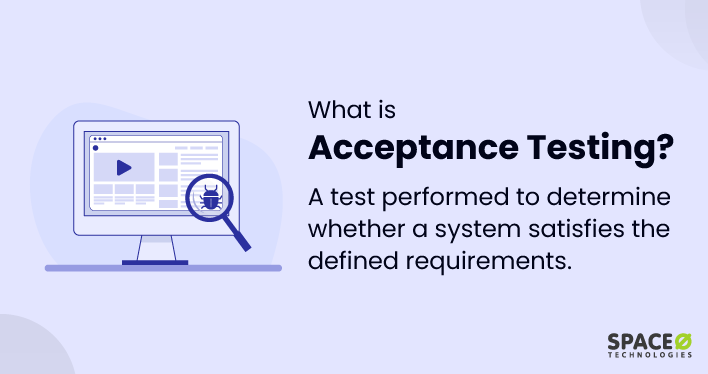Table of Contents
What is Acceptance Testing?
Acceptance testing is a type of testing performed to determine whether a system or software satisfies the specified business requirements for delivery. Also known as user acceptance testing, it is typically conducted by real end-users or clients, or by testers acting on their behalf.
The objective of acceptance testing is to evaluate the overall functionality, performance, and usability of the software or system under real-world scenarios. UAT ensures it meets the user’s needs and is ready for deployment in a production environment.
Acceptance testing is a crucial component of the broader process of web and software testing process, which involves a multitude of other testing types such as unit testing, integration testing, system testing, performance testing, and security testing, each with its own objectives and scope. These tests can be conducted in different phases of a software development life cycle, ensuring that each part of the application is tested and validated.
For further and comprehensive insight into the different types of software testing, including acceptance testing, you may refer to the following link to access our guide on web application testing process.
What are the Benefits of Acceptance Testing?
Acceptance tests provide 8 core benefits for web and software development projects:
User-centricity
The acceptance tests focus on the user’s perspective and their needs. It verifies that the system behaves as expected and meets user requirements, which can significantly increase customer satisfaction.
Risk Mitigation
By verifying that the software functions as required before it is released, acceptance testing can mitigate the risk of problems being discovered after deployment, which could lead to costly fixes and potential damage to the business’s reputation.
Improved Quality
Acceptance tests help to improve the quality of the product by detecting any defects or issues before the product is released. This allows for the product to be fine-tuned and improved upon until it meets the expectations and needs of the users.
Regulatory Compliance
In certain industries, acceptance testing can be necessary for regulatory compliance. The regulations’ acceptance testing ensures that software meets certain standards and specifications.
Reduced Costs
Catching and correcting issues before the product launch reduces the costs associated with fixing bugs post-launch.
Confirm Business Needs
The acceptance tests validate that the system fulfills the specified business requirements and works correctly in real-world scenarios.
Smooth Deployment
An acceptance test ensures that the transition from the development testing environment to the production environment is smooth and that the application is ready for use.
End-user Confidence
An acceptance test builds confidence among end-users as they are involved in end-user testing, ensuring that the application is fit for its testing purpose.
By ensuring that the software and web app are functional, user-friendly, and reliable, an acceptance test provides crucial insights that can guide final adjustments before product release.
What are the Types of Acceptance Testing?
Acceptance testing can be classified into different types of testing techniques, depending on the specific context or phase in which it is conducted:
User Acceptance Testing (UAT)
This is the most common form of acceptance testing and is typically performed by the end users. UAT aims to validate the entire system in a real-world scenario from the user’s perspective to ensure the software can handle required tasks in real-world scenarios, according to specifications.
Business Acceptance Testing (BAT)
The business acceptance test focuses on validating whether the software meets the defined business processes and is capable of fulfilling the business needs. It’s usually done by business analysts.
Alpha and Beta Testing
In alpha testing, internal staff/alpha testers perform an acceptance test in the test-driven development environment, whereas beta testing is conducted by a limited set of external users/beta testers in the environment. Both these tests are used to catch remaining flaws before the product goes to market.
Operational Acceptance Testing (OAT)
OAT, also known as production acceptance testing, verifies the operational readiness of a software application prior to its release or deployment. It focuses on aspects like system backup, user access control, and maintenance procedures.
Contract Acceptance Testing
The contract acceptance test is done when developed software is based on contractual specifications. The test results ensure that all contractual requirements are met by the software.
Regulation Acceptance Testing (Compliance Acceptance Testing)
This is performed when the software needs to comply with the regulations defined or the regulatory principles like government or legal rules. The regular acceptance test plan validates whether the system meets the required regulations or not.
Factory Acceptance Testing (FAT)
Usually carried out by software developers on the software side, it checks that the system meets the service level agreement criteria so that it can be fully accepted by the user.
Each type of acceptance testing plays a crucial role in ensuring that the software meets user needs, business requirements, and regulatory standards. Additionally, these tests are necessary to validate the software’s performance and functionality in various real-world scenarios.
Throughout these processes, regression testing is continuously performed to ensure that new changes or updates to the software don’t cause any previously passed tests to fail. If you’re not familiar with what regression testing is, you can refer to the post that provides a brief definition of regression testing. Overall, acceptance testing assures that the final product is of high quality, reliable, and ready for deployment in its intended environment
In conclusion, acceptance testing is an essential step in the web app and software development process, focusing on confirming the system meets the specific user as per acceptance criteria. It offers numerous benefits such as improved product quality, risk mitigation, and increased user satisfaction. With various types of acceptance testing available, it allows for thorough and diverse evaluations, ensuring a comprehensive assessment of the software before it’s launched, contributing significantly to the successful deployment of a reliable and efficient software application.






